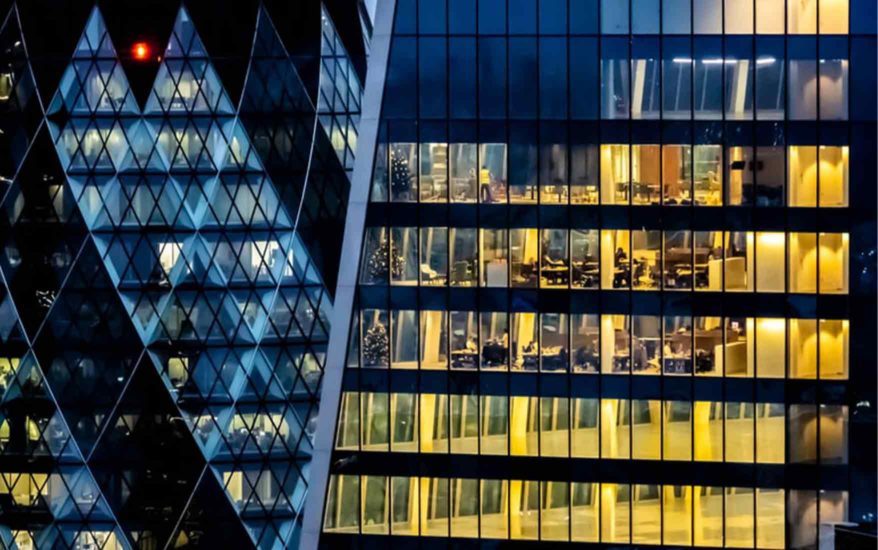
Companies typically overspend on their real estate. Occupancy sensors can collect usage data that allows to cut costs by pinpointing what companies need, and how to adapt it to their dynamic workforce.
Energy is also subject to waste, which is why more emphasis should be put on practices for reducing energy consumption in the office.
But how can you reduce energy consumption in the office?
Office life consumes huge amounts of energy; 13 million employees in 208 million m2 of office buildings consume 263 kWh per m2, per year. Commuting is also high; an average commute is 10 miles per day, or more than 4350 miles per year.
The energy usage of office activity alone represents 25 per cent of overall energy consumption of the whole tertiary sector. Heating is the highest consumer, accounting for half of all energy consumption. The consumption of specific electricity (lighting, computers, air conditioning etc.) comes in second place.
To ensure a sense of wellbeing within the office, smarter behaviours, and practices can be utilised to save energy, while keeping employees happy.
Heating and air conditioning
Office temperature is an essential factor in the welfare of employees. In order to achieve significant savings, it is often necessary to make significant investments, ensuring your heating and cooling systems are in good order and working effectively. However, some small changes can help:
In Winter:
- Adjust the thermostats or radiators to obtain the right temperature. Lowering the temperature by 1° C cuts 7 per cent of energy consumption.
- Warn Technical Services if your office is overheated or under-heated (especially in case of cold air intake).
- Avoid bringing your own heater, or using extra heaters.
- Turn off heaters when opening windows or airing the office space.
In Summer:
- Avoid operating air conditioning systems.
- Ventilate the office during cooler hours.
- Keep windows and blinds closed during the day.
- Stir the air with ceiling fans – they provide a sensation of freshness.
- Avoid using any lighting that produces heat.
- If air conditioning usage is unavoidable, close the windows and adjust the temperature to 4° C below the outside temperature, without falling below 26° C. If the temperature difference is too high, pay attention to thermal shock.
Office layout:
Thermal comfort can be improved if workstations are not placed near exterior walls or windows; the cold wall effect in winter or overheating in summer is thus avoided if insulation is sufficient. The location of thermostats must also be considered with the same precautions.
Electricity
In the office, just like at home, simple gestures applied systematically can help to reduce electricity consumption:
Lighting:
- Turn off lights when you’ll be absent for a long time, and in the evening when you leave.
- Use natural light by placing your desk perpendicularly to the window.
The computer:
- Use sleep mode with discernment. A computer on standby still consumes 20 to 40% of power when switched on.
- Switch off the display instead of using standby.
- Avoid screen savers that use 3D effects, as they can consume even more energy than active mode.
Printer and copier:
- Equip the office with a multifunction device (printer/photocopier/scanner in one).
- Connect all computers to a network printer and copier rather than equipping each station with an individual printer.
- Use the photocopier to copy in large quantities, rather than printing in large quantities.
Portable devices:
- Do not leave the chargers of portable devices in the socket; they continue to consume energy as long as they are connected.
- The power strip is a valuable accessory that allows you to turn off all the devices connected to it at once. Be careful not to overload the power strip by always observing the maximum power connected to it.
- Finally, when choosing equipment, choose energy-efficient equipment that can be identified with the Energy Star logo.
Traveling
Business travel and commuting also generate energy consumption, along with emissions of pollutants and greenhouse gases.
It is possible to limit travel by using modern technology. Organising telephone meetings or video integrated meetings saves fuel, avoids the emission of pollutants and saves time. For all absolutely necessary travel, try to choose venues that are closer to your own location, and choose travelling by train rather than car or plane, where possible.
For daily trips, there are several ways to reduce impact:
- If the commute is short in distance, getting to work on foot or by bike can be preferable
- If the commute is longer, make the most of public transport
Those who have no option but to commute via car may nevertheless adopt behaviors such as:
- Propose to share car trips with colleagues
- Take a flexible vehicle and drive at a moderate pac
- Avoid the use of air conditioning
- Maintain the vehicle regularly
With the environmental and climatic challenges, we face, we have the power to act; to be an initiator or a prescriber in the office and reduce pressures on the environment through gestures and behaviors that are simple to implement.
*This article was compiled by Zena Rabia, Head of Marketing, West & South Europe at Condeco



